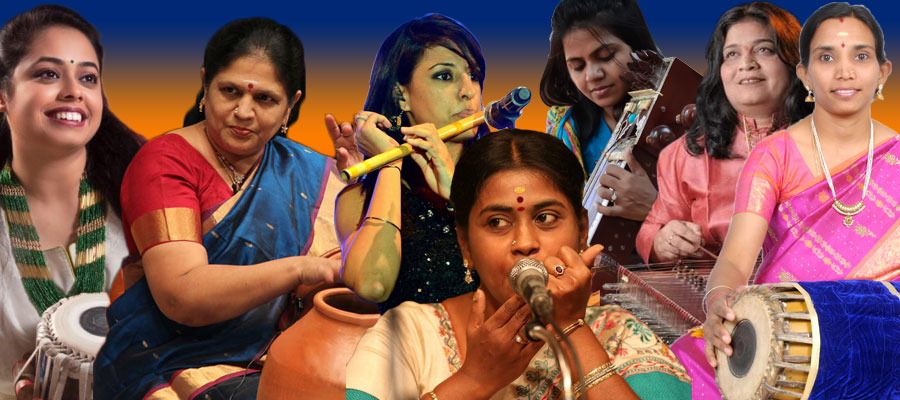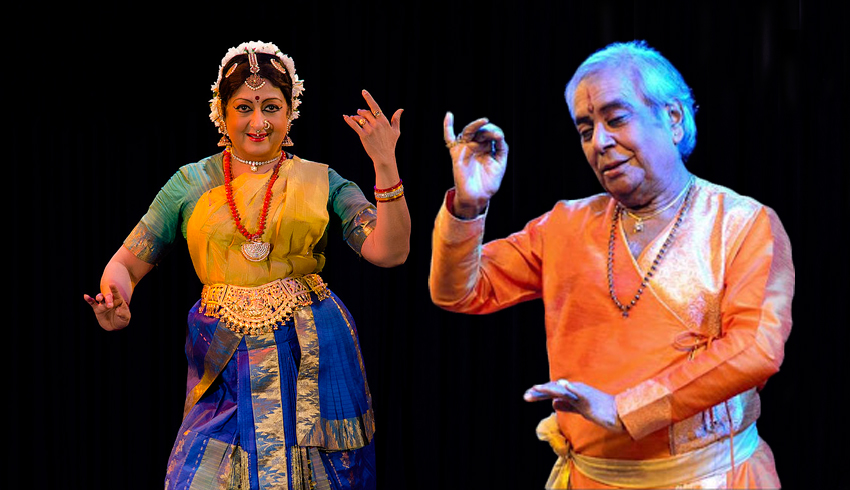On International Women’s Day, one of the happiest domains to explore is probably the gender roles in Indian Classical Music. To put it more appropriately, in Indian Classical Music, both men and women have an equal stature as professionals and both genders have been accepted equally by audiences as performers on a public platform for general entertainment. This is not surprising particularly because women have been central to public performances in Indian culture since the days of temple worship and the development of the Devdasi culture. In fact, gender roles in Indian Classical Music mostly stand true to the spirit of International Women’s Day, which was established for the contribution of women to the society and had vowed for equal rights and opportunities for women at the work place.
A closer examination of the sculptures in the Hindu temples located in the Southern and Central parts of India like Hampi and Khajuraho have ample and democratic representation of musicians – both men and women, playing instruments like the Mridangam, Flute, Khanjeera etc which are considered to be “male-dominated” in common perception. Music has not just been an important part of the process of deity worship in India through centuries but in the Hindu Pantheon, the deity who represents music and learning is a woman – Goddess Saraswati.
There are several factors in India which have led to the seamless transition from the Mughal Era to the present day with more women taking to music professionally. This is a unique phenomenon especially because otherwise, we are still considered a male-dominated society. Interestingly, in many cultures in the West, the role of women in music has been very restrictive and encumbering since the remote past. For example, it was considered a great taboo for women of the Dinaric cultural zone in former Yugoslavia to come into direct contact with any musical instrument. In Swedish Folk music, women are traditionally forbidden to play the horn and the fiddle. The Middle-east still remains somewhat of a dinosaur as far as female singers or performers are concerned and in many Turkish villages, it is still considered a matter of shame for a woman to touch a musical instrument. We were also pleasantly surprised to know that the first female musician in the Vienna Philharmonic Orchestra was a Harpsichord Player who was added to the ensemble only as recent as in 1997.
In this context, Indian Classical Music – both Hindustani and Carnatic – has remained largely liberal and democratic through ages. If you recall most Indian instruments, there are as many female names that pop up alongside the male names who represent so-called male-dominated instruments. Such women in India have etched a name for themselves, not always without a bit of struggle but certainly on the basis of the quality of their music.
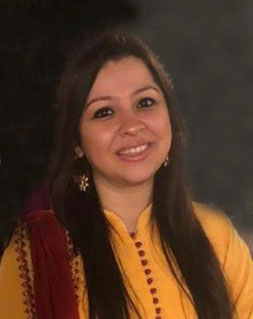
According to Mumbai-based event manager, Nayaab Udhas, owner of The Event Company, women are doing a lot more work in the field of perceptually male-dominated instruments and music in general nowadays. “If you look closely, women have more responsibilities on their shoulders in a family and society. Taking up music as a profession by women is not a new trend in India and requires a lot of courage and additional responsibilities. As an event manager, I can also confidently tell you that the women who play a male-dominated instrument get paid at par with their male counterparts. The openness of the musicians, their families and the audience in general is far from male-dominated and stands on the foundations of equality and freedom of choice.”
We spoke to many female stalwarts who gave us a glimpse into their journey as a performer /representative of a perceptually ‘male instrument’. Some of the journeys have seen progress only with struggle, however, not a single one of them faced any obstruction nor were judged by anybody for choosing a male-dominated musical instrument over singing or a ‘gentler’ musical instrument.
Sukkanya Ramgopal (Ghatam)
Sukkanya is a veteran of this instrument. Her initial years went away in learning vocal and violin, however, her inner pull towards rhythm and complex rhythmic patterns took her away to Guru, Sri T. R. Harihara Sharma, who was the father of the legendary Ghatam exponent, Vikku Vinayakram Sharma.
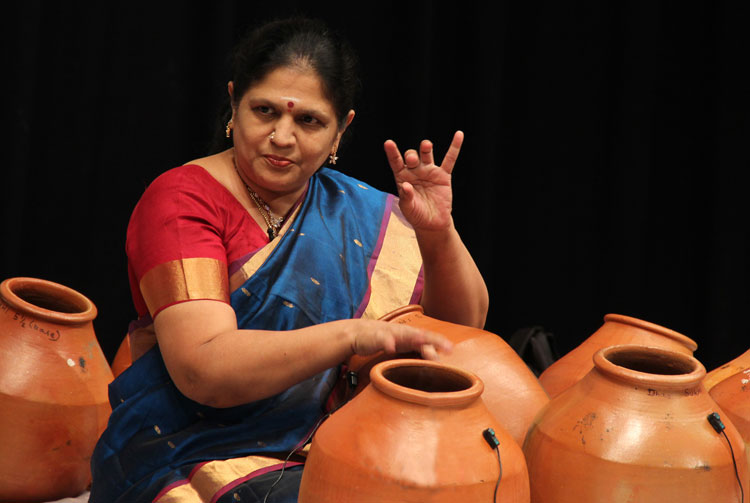
She later trained from Vikku Vinayakram Sharma too and besides playing regular concerts, formed an all-female ensemble comprising of Ghatam, Morsing, Mridangam and Khanjeera to create a better platform for women who play male-dominated instruments.
“I sincerely feel that people should remember us throughout the year and not just on Women’s Day. We have had to fight many misconceptions, especially with instruments like the Mridangam; many people still think that only a man, with his power and strength, can bring about the intricate beauty of the instrument which I do not agree with,” she states.
As far as payments are concerned, she is of the opinion that there is no disparity towards women by All India Radio. However, she also points out that private organizers do keep the order of priority of amounts as – Main Artist, Violin, Mridangam, Kanjeera, Ghatam and then Morsing – exactly in that order.
[adrotate group=”9″]
Ranjani Venkatesh (Mridangam)
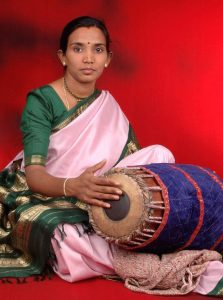
“I belong to a family of Carnatic musicians where there was not a single Mridangam player. Whenever my mother, father or my relatives performed on stage, they had to hire a Mridangam player and perform. When my parents saw my deftness with rhythms, they put me on to the Mridangam from age 10. Ours was a small village called Bellary where I started learning and began performing on stage from the age of 15. Till we moved to Bangalore, I did not even have an iota of information or perception that Mridangam is considered a male-dominated instrument. After I was confronted with this idea for the first time in Bangalore, I took it up as a challenge. However, Mridangam, for me, is an instrument and I personally do not see anything ‘male’ or ‘female’ about it. But of course, I feel proud that people come and acknowledge me as a female in the field.”
Dr. Varsha Agrawal (Santoor)

“I have been performing since 1977 so it has been more than 3 decades now. But one thing I must admit that I have never faced any gender discrimination ever since I went out there as a female Santoor player. Rather, people are very accepting and given the epitomization of the instrument by males mostly, it comes as a pleasant surprise for them when they see me performing. I have been pleasantly surprised especially in the West where I have seen some audiences come up to me and tell me that they know this is a male-dominated instrument from Kashmir. Yesterday, I performed in benares at the Dhrupad Mela to a huge audience. Benares being home to some of the biggest male stalwarts of Indian Classical Music, has always been one of my favourite destinations for a concert because the audiences express no surprise to see a woman playing a Santoor. Last night, amongst those who came and met me after the concert, there were parents who have come and expressed to me that they want to initiate their daughters to Santoor. That is what makes me the happiest as a woman. There is no male domination in the world of Indian Classical Music.”
[adrotate group=”9″]
Rasika Shekar (Flute)
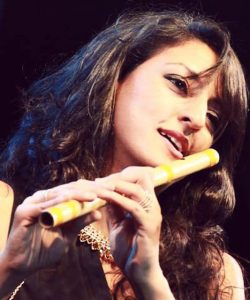
“My story of taking to the flute is actually quite a simple one – I was learning Carnatic Classical Vocal. One day, I found a flute lying in my balcony and started fiddling with it and playing on it. My mother noticed and thought that maybe this is what I should learn because according to her, I was showing some promise. Later on, when I went to my Guru, I started learning various facets of this instrument and I must tell you that my Guru never even pointed out to me once that there was anything predominantly male about it – even though Bansuri is associated with Lord Krishna. I grew up learning the nuances of the instrument and for me, it is it is what I found myself deeply connected to. I also feel that in this day and age, music has become more of a global language of communication: I had once performed to a Tunisian audience and I remember every member of the audience coming up to me and expressing how thrilled they were just to listen to the music. No one pointed out to me that I was a woman and that I was playing a male instrument. The Indian flute being primarily made from Bamboo, is the most natural instrument with a gorgeous sound and for me, it is how I express my feelings, thoughts and emotions through music. The instrument is just a medium. I have never been made to feel conscious about playing the flute ever – not by my parents, nor my Guru – not even the audiences.”
Savani Talwalkar (Tabla)
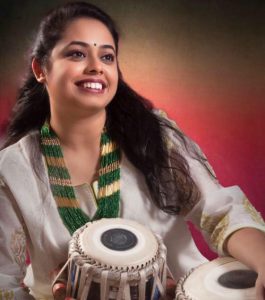
“I don’t even remember when I got initiated to the Tabla since both my parents are musicians and music was only a natural endowment and the obvious choice for me and my brother, Satyajit. I remember that most of the students who learned from my father, Pt. Suresh Talwalkar, were boys. But that apart, I was never shown any gender discrimination. One thing I must tell you is that, I give a lot of credit to the audiences in India for their whole-hearted acceptance of me and so many other women who are playing Tabla to huge audiences today. It hardly matters to them whether the musician is a male or a female – as long as the quality of the music is good, I guess you will get accepted the way you are. Oh yes, I do face an odd question or two sometimes from very senior people after a concert. ‘Don’t your hands pain?’ Women have taken to every profession these days. I wonder if they will ever go and ask a lady surgeon, ‘Don’t your hands pain?” (Laughs).
[adrotate group=”9″]
Manonmani (Sarangi)

“My mother is a Dilruba and Esraj player and has played on thousands of recordings in the film industry, particularly in the South of India. I think she is the only female musician in India playing those instruments. She has played for Illayaraja and still works in Rahman Sir’s songs. The strains that you get to hear in some of the most popular and best songs by Rahman Sir, like Urvashi Urvashi or Tu Hi Re, have all been rendered by her. But both my parents kept discouraging me all the more whenever I showed any interest in becoming a musician. I was a software engineer by profession, but after my marriage, I convinced my husband about my love for music and that this conflict within me could only be resolved if I took up music full time. I eventually landed up finding the Sarangi and took to it. Reason? Well I have always had an eye for the challenging, difficult and unconventional. I play a lot of fusion concerts these days and I also do a lot of studio recordings. However, I want to play full recitals of Classical Music and I am working hard on it.”
Bhagyalakshmi M Krishna (Morsing)
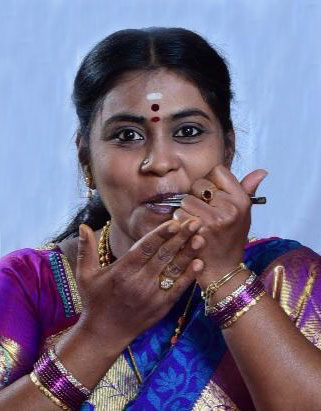
“My father and brother – both play the Morsing and I have received my training from my father. Yes, it is slightly special to be identified as a “lady who is playing the Morsing” because audiences are used to seeing only males play the instrument. Every concert of mine turns into a post-concert lec-dem (laughs). This is because I can bring out very different sounds from the Morsing and have been especially trained to do so. But I must also admit that audiences have a special regard for me because I constantly keep giving them quality work. I am sure that if the quality of my music deteriorates, I will no longer enjoy the special attention that I usually get from my listeners. Yes, I do feel proud sometimes that I am compared to many males in the profession and hailed a better musician by my discerning listeners.”
[adrotate group=”9″]



